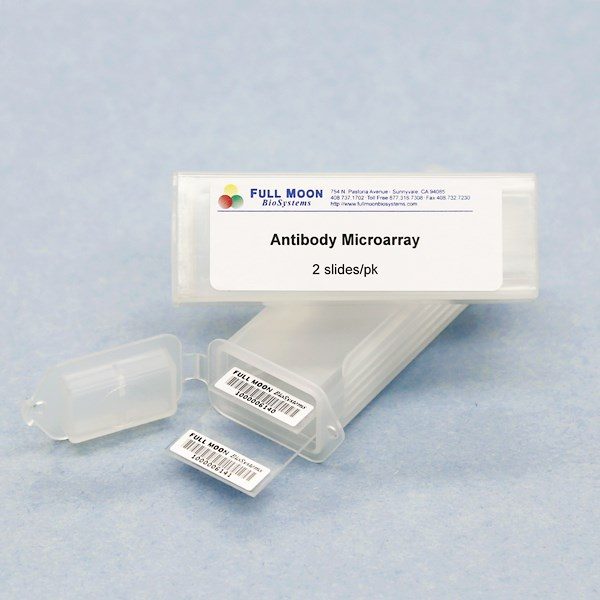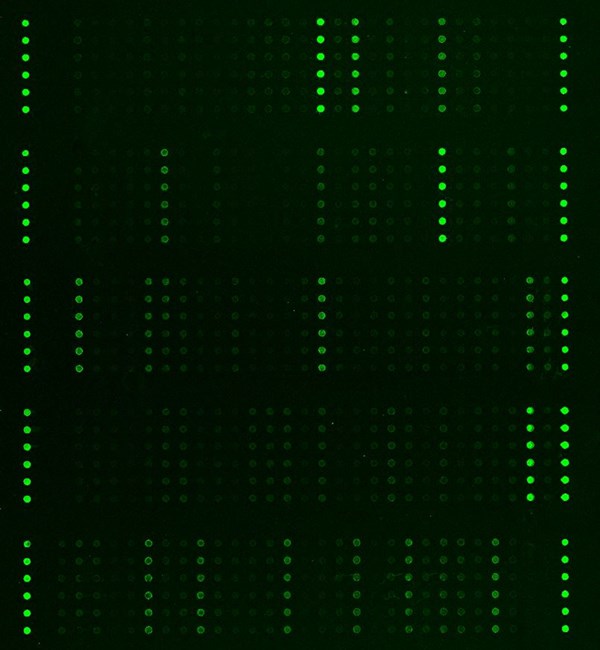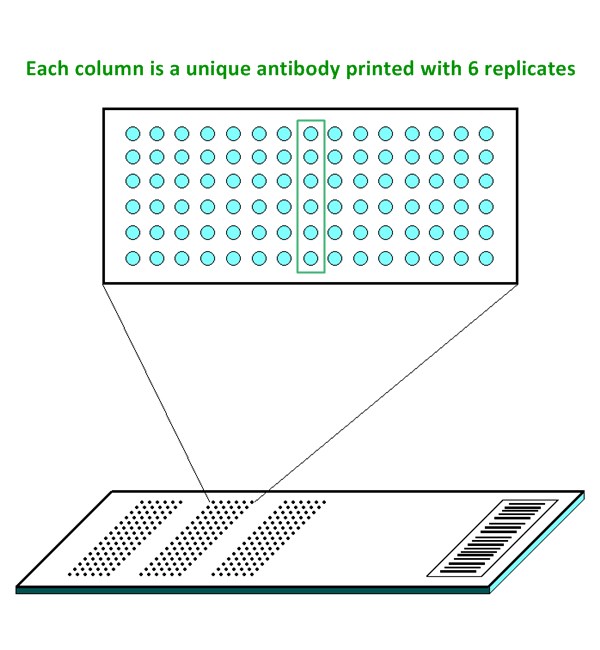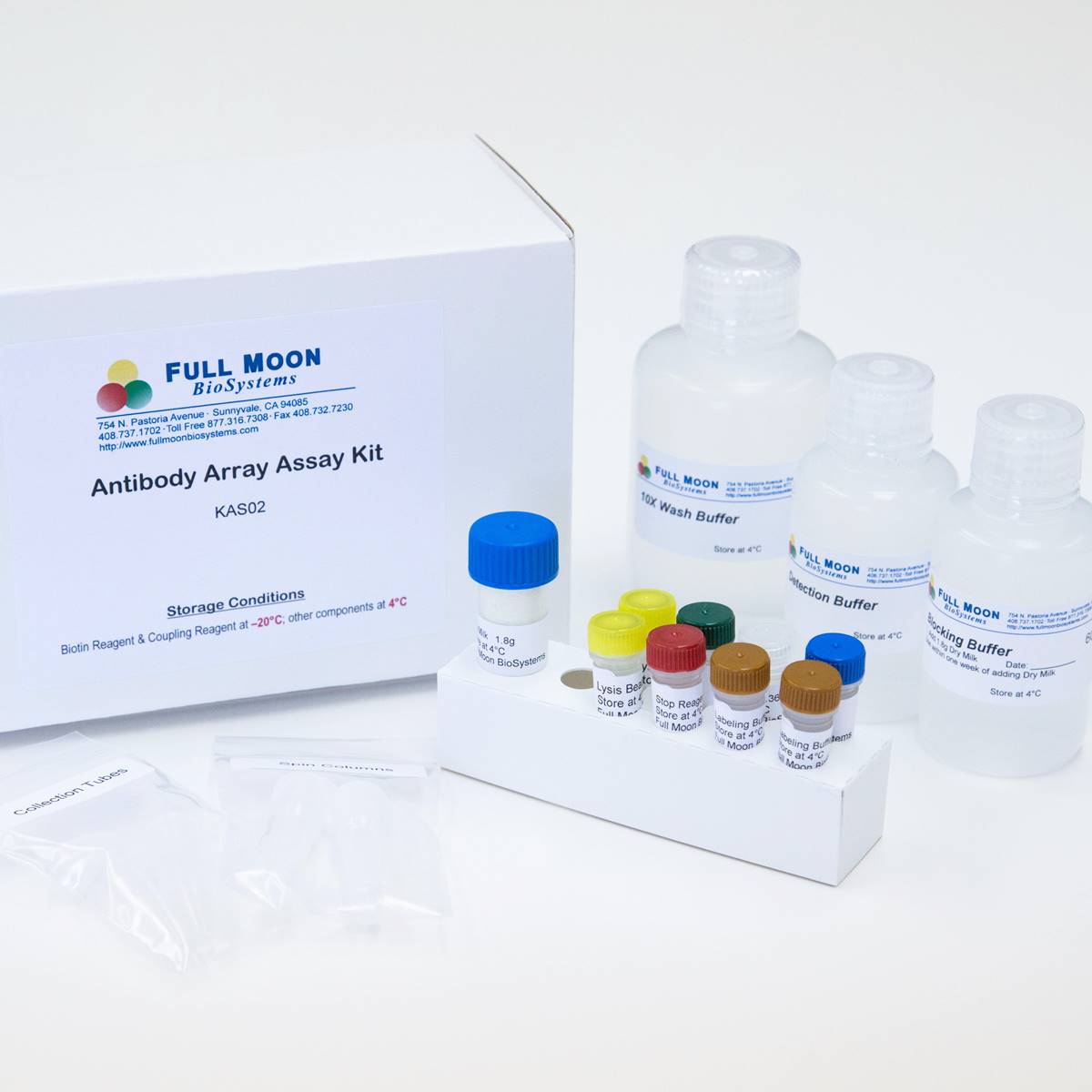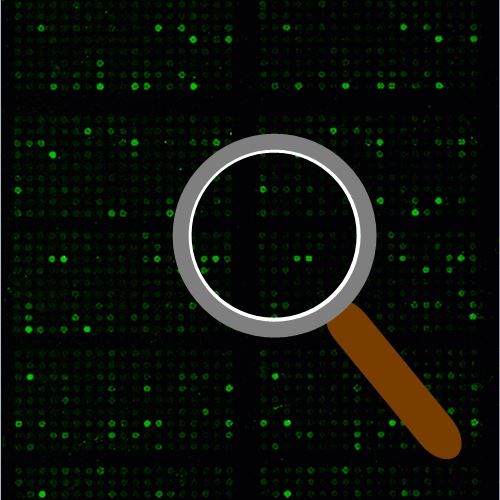Apoptosis Phospho Antibody Array
Apoptosis Phospho Antibody Array is a high-throughput ELISA based antibody array for qualitative protein phosphorylation profiling and screening. This array is designed for comparing normal samples to treated or diseased samples, and identifying candidate biomarkers. This array features site-specific and phospho-specific antibodies, allowing researchers to study serine/threonine and tyrosine phosphorylation at specific sites.
Key Features
- Site-specific phosphorylation profiling and screening with 247 antibodies
- Antibodies covalently immobilized on 3D polymer coated glass slide
- Six replicates per antibody
- Fluorescent detection
Specifications
| Product Size: | 2 array slides per package for analyzing two samples (untreated vs. treated) |
| Featured Antibodies: | 247 site-specific and phospho-specific antibodies |
| Reactivity: | Human: 100% | Mouse: 89% | Rat: 65% |
| Suitable Sample Type: | Cell lysate | Tissue lysate |
| Detection Method: | Fluorescence | Compatible Scanners |
| Internal Controls: | beta-actin | GAPDH | Negative controls |
| Slide dimensions: | 76 x 25 x 1 mm |
| Storage Condition: | 4°C for 6 months |
Product Details
14-3-3 theta/tau (Ser232), 14-3-3 zeta (Ser58), 14-3-3 zeta/delta (Thr232), AKT (Ser473), AKT (Thr308), AKT1 (Thr72), AKT1 (Tyr474), AKT2 (Ser474), A-RAF (Tyr301/302), ASK1 (Ser83), ASK1 (Ser966), ATRIP (Ser68/72), BAD (Ser112), BAD (Ser134), BAD (Ser136), BAD (Ser155), BAD (Ser91/128), BCL-2 (Ser70), BCL-2 (Ser87), BCL-2 (Thr56), BCL-2 (Thr69), BCL-XL (Ser62), BCL-XL (Thr47), BID (Ser78), BIM (Ser69/65), B-Raf (Ser446), B-Raf (Ser601), B-Raf (Thr598), CaMK2 (Thr286), Casp3 (Ser150), Casp6 (Ser257), Casp8 (Ser347), Casp9 (Ser144), Casp9 (Ser196), Casp9 (Thr125), Casp9 (Tyr153), Casp10, CDC2 (Tyr15), CDK1/CDC2 (Thr14), Chk1 (Ser280), Chk1 (Ser286), Chk1 (Ser317), Chk1 (Ser345), Chk2 (Ser516), Chk2 (Thr383), Chk2 (Thr387), Chk2 (Thr68), c-Jun (Ser243), c-Jun (Thr91), Cytochrome c, DAXX (Ser668), ERK1/2, FADD (Ser194), Fas, FKHR (Ser256), FKHR (Ser319), FOXO1/3/4-PAN (Thr24/32), FOXO1A (Ser329), HSP27 (Ser15), HSP27 (Ser78), HSP27 (Ser82), HSP90A, HSP90B (Ser226), HSP90B (Ser254), IkB-alpha (Ser32/36), IkB-alpha (Tyr42), IkB-beta (Thr19), IkB-epsilon (Ser22), IKK alpha (Thr23), IKK beta (Tyr188), IKK beta (Tyr199), IKK gamma (Ser31), IKK gamma (Ser85), IKKa/b (Ser180/181), JNK1/2/3 (Thr183/Tyr185), Lamin A/B (Lamin A/C) (Ser392), Lamin A/C (Ser22), MKK7/MAP2K7 (Ser271), MKK7/MAP2K7 (Thr275), NFkB-p100 (Ser872), NFkB-p100/p52 (Ser865), NFkB-p100/p52 (Ser869), NFkB-p105 (Ser927), NFkB-p105/p50 (Ser337), NFkB-p105/p50 (Ser893), NFkB-p105/p50 (Ser907), NFkB-p105/p50 (Ser932), NFkB-p65 (Ser276), NFkB-p65 (Ser311), NFkB-p65 (Ser468), NFkB-p65 (Ser529), NFkB-p65 (Ser536), NFkB-p65 (Thr254), p44/42 MAPK (Thr202), p44/42 MAPK (Tyr204), p53 (Ser37), p53 (Ser392), p53 (Ser6), P70S6K (Ser371), P70S6K (Ser411), P70S6K (Ser418), P70S6K (Ser424), P70S6K (Thr229), P70S6K (Thr389), P70S6k (Thr421), P70S6K-beta (Ser423), P90RSK (Ser380), P90RSK (Thr359/Ser363), P90RSK (Thr573), PI3K-p85-a/g (Tyr467/Tyr199), PKC pan activation site, PTEN (Ser370), PTEN (Ser380), PTEN (Ser380/Thr382/Thr383), SAPK/JNK (Thr183), SAPK/JNK (Tyr185), Survivin (Thr117), TAK1 (Thr184), TNFR1, TNFR2, XIAP (Ser87)
The ELISA based AKT/PKB Phospho Antibody Array platform involves four major steps:
- Protein extraction with non-denaturing lysis buffer
- Biotinylation of protein samples
- Incubation of labeled samples with antibody array
- Detection by dye conjugated streptavidin
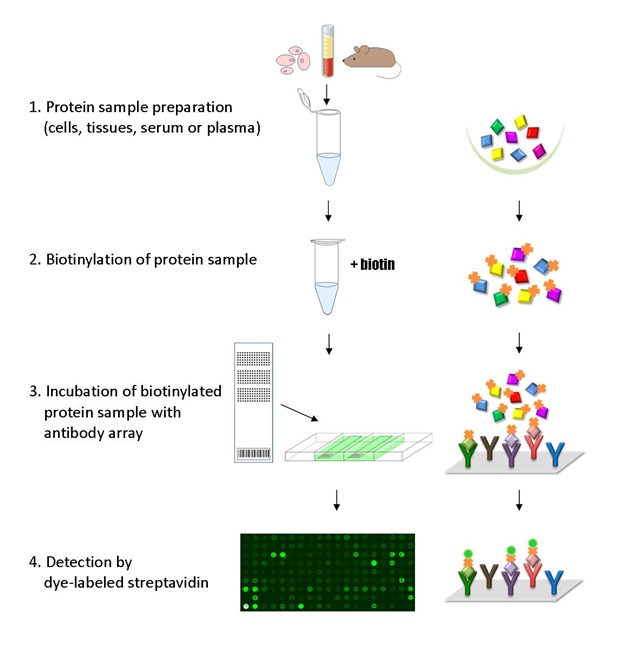
![]() GAL File (To download, right click on the file name, then choose “Save target as”)
GAL File (To download, right click on the file name, then choose “Save target as”)
Daneshmandi S, Choi JE, Myeloid-derived suppressor cell mitochondrial fitness governs chemotherapeutic efficacy in hematologic malignancies, Nat Commun. 2024; 15: 2803. doi: 10.1038/s41467-024-47096-9
Deng Y, Zeng X, Cdyl2-60aa encoded by CircCDYL2 accelerates cardiomyocyte death by blocking APAF1 ubiquitination in rats, Exp Mol Med. 2023 Apr 3. doi: 10.1038/s12276-023-00983-5
Fan H, Yang L, Cardioprotective effects of salvianolic Acid a on myocardial ischemia-reperfusion injury in vivo and in vitro, Evidence Based Complement Alternative Medicine 2012, 2012:508938
Saykally JN, Hatic H, Withania somnifera Extract Protects Model Neurons from In Vitro Traumatic Injury, Cell Transplant. 2017;26(7):1193-1201
Services
If you don’t have access to a microarray, send the finished arrays to our lab for scanning. Raw scan images are delivered in tiff format.
Cost: Free
Array Image Quantification and Analysis Service includes data extraction, data organization and analysis of the array images obtained through our array scanning service.
Cost: $250 per slide
Complete Antibody Array Assay Service allows investigators to send research samples to our laboratory for analysis. There is no need to purchase the arrays and reagents and running the assays yourself. Simply select the array of your choice, and then send off the samples to our lab. This convenient hands-off approach offers quick turnaround and reliable results, saving you valuable time and resources. All assays will be performed by our highly trained scientists at our headquarter in Sunnyvale, California. Results are delivered by email in 1-3 weeks.
Cost: $1,520 per sample

